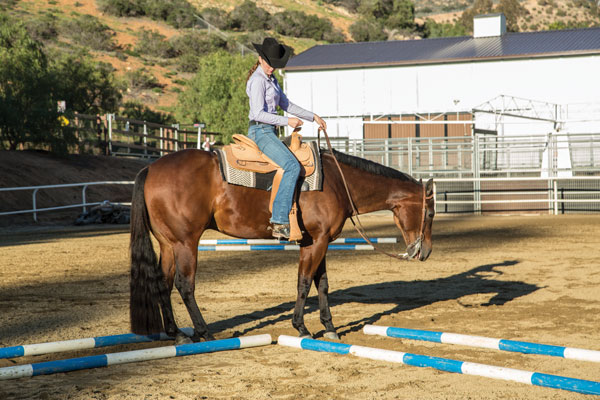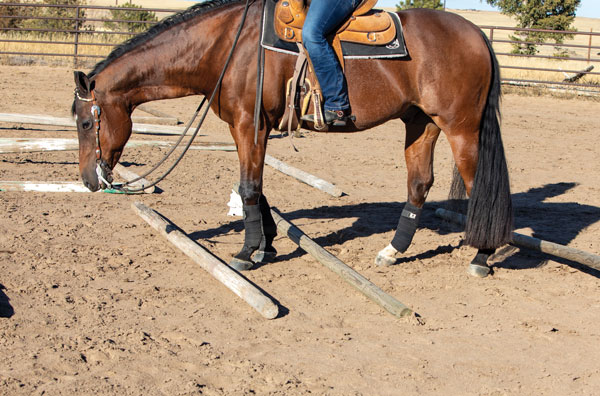Western Trail Class Dos and Don’ts


To score well in horse show trail classes, you must pay attention to details. Glancing in the wrong direction or allowing your horse to take an extra step between carefully measured poles can cost precious points. Top trainer Shaun Gloude of Franktown, Colo., understands how important it is to learn and practice western trail class rules. She helps her amateur and youth clients prepare for and succeed at high-level American Quarter Horse Association shows.
Here, she discusses the trail class mistakes she sees frequently. When it comes to stepping over poles, backing, and loping your horse over poles and into a box, she’ll show you what to do—and what to avoid.


Trail Mistake 1: Backing Position
If your pattern calls for backing your horse with a turn, make sure that your posture and position don’t cause your horse to shift his weight and back in a crooked line.
The Right Move: As you back, keep your shoulders square. If you’re backing in an L-shape, glance down at the rails with as little head tilt as possible. Make sure to look to the side of the continuous rail (if you’re turning to the right, look to the right).
Don’t Do It: If you lean far to the side to see where your horse’s hooves will go, you will cause your horse to shift his weight away from the straight line.
Trail Mistake 2: Too Many Steps
Walking or trotting over poles is a common trail class addition. While the move seems easy, you must know when to allow your horse to step one or two hooves between the poles. Poles are set at 24- or 36-inch distances.
If the space between two poles is 24 inches, allow your horse to place one front hoof in the space. If the space is 36 inches, your horse may place two front hooves before moving on.
The Right Move: In this four-pole pattern, you must step over the first pole, help your horse place two steps in the first opening, then allow only one step in the smallest pole opening.
Don’t Do It: That small distance between the second and third poles isn’t enough space for two steps. Move your horse on and don’t allow him to place two front hooves in that smallest opening. If your horse takes two steps in that space, you’ll get a 1-point penalty.
Trail Mistake 3: Stopping Too Late
Loping into a box in the western trail class shows off your ability to stop on command. Look ahead and know how soon to cue your horse for the halt so that you don’t overshoot the box.
The Right Move: Lope your horse over one side of the box, then cue him to stop right away. Practice, practice, practice until you can stop while your horse keeps all his hooves inside the box.
Don’t Do It: You’ll incur a penalty if your horse stops with a foot outside the box.
Trail Mistake 4: Turning Wide
Once you’re in the box, make a 360-degree turn. If your turn is too wide, your horse will step out of the box, incurring a penalty.
The Right Move: Keep your horse’s hooves inside the box. Use your leg cues to show your horse that you need a sharp turn. Look in the direction you want to go and allow your horse enough rein to put his head down so that he can navigate the box.
Don’t Do It: If you allow your horse to move forward into a wide turn, you’ll step out of the box.
Each of these maneuvers takes practice to master. Work on maneuvers until your horse gets it right, then move on to practice something else when you’ve achieved success. Your horse will learn what’s expected of him, and you’ll learn how to cue for your horse’s individual movements when you spend time practicing together—but always ending on a good note.
Thanks to Megan Worley and Set To Blaze (aka “Rodney”) for modeling.
This article about western trail class dos and don’ts appeared in the August 2020 issue of Horse Illustrated magazine. Click here to subscribe!
Recent Posts
A Recap of Road to the Horse 2025
Road to the Horse is an exciting, unique colt-starting event, dedicated to changing people’s ideas and creating a better world…
2025 Defender Kentucky Three-Day Event: An Impressive List of Entries
Lexington, Ky. — Six of the world’s top 12 eventing riders, including World #1 Tom McEwen (GBR) and World #2…
2025 Defender Kentucky Three-Day Event
Stay up to date on the action from the 2025 Defender Kentucky Three-Day Event. Find information about the event, including…
Ryan Rose: Creating Strong Partnerships Between Horses and the People Who Love Them
Ryan Rose got bit by the cowboy bug early in life. "My love of horses started when I was a…
Breed Profile: European Brabant
While draft horses come in many shapes and sizes, from the gigantic Shire to the smaller Haflinger, most have something…
The Working Mules of our Public Lands
Flopping ears bounce with every step down the trail as a string of six mules begin the trek from the…